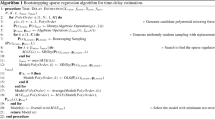Abstract
Careful control of joint impedance, or dynamic joint stiffness, is crucial for successful performance of movement. Time-varying system identification (TV-SysID) enables quantification of joint impedance during movement. Several TV-SysID methods exist, but have never been systematically compared. Here, we simulate time-varying joint behavior and propose three performance metrics that enable to quantify and compare TV-SysID methods. Time-varying joint stiffness is simulated using a square wave and subsequently estimated with three TV-SysID methods: the ensemble, short data segment, and basis impulse response function method. These methods were compared based on (1) bias with respect to the simulated joint stiffness, (2) random error across 100 simulation trials, and (3) maximum adaptation speed in joint stiffness that can be captured. This approach revealed that each TV-SysID method has its own unique properties. The simulation method and performance metrics pave the way for developing a framework to quantify the strengths and weaknesses of TV-SysID algorithms for estimating joint impedance.
This work is part of the talent programme VENI with project number 17351, which is financed by the Dutch Research Council (NWO).
Access this chapter
Tax calculation will be finalised at checkout
Purchases are for personal use only
Similar content being viewed by others
References
R.E. Kearney, I.W. Hunter, System identification of human joint dynamics. Crit. Rev. Biomed. Eng. 18, 55–87 (1990)
C.G. Meskers et al., Muscle weakness and lack of reflex gain adaptation predominate during post-stroke posture control of the wrist. J. Neuroeng. Rehabil. 6, 29 (2009)
R. Xia, M. Radovic, A.J. Threlkeld, Z. Mao, Z., System identification and modeling approach to characterizing rigidity in Parkinson’s disease: neural and non-neural contributions, in 4th International Conference on Bioinformatics and Biomedical Engineering (2010)
I.W. Hunter, R.E. Kearney, Dynamics of human ankle stiffness: variation with mean ankle torque. J. Biomech. 15, 747–752 (1982)
M.M. Mirbagheri, H. Barbeau, R.E. Kearney, Intrinsic and reflex contributions to human ankle stiffness: variation with activation level and position. Exp. Brain Res. 135, 423–436 (2000)
J.B. MacNeil, R.E. Kearney, I.W. Hunter, Identification of time-varying biological systems from ensemble data. IEEE Trans. Biomed. Eng. 39, 1213–1225 (1992)
D.L. Guarin, R.E. Kearney, Estimation of time-varying, intrinsic and reflex dynamic joint stiffness during movement. Appl. Ankle Joint Front Comput. Neurosci. 11, 51 (2017)
D. Ludvig, E.J. Perreault, System identification of physiological systems using short data segments. IEEE Trans. Biomed. Eng. 59, 3541–3549 (2012)
Author information
Authors and Affiliations
Corresponding author
Editor information
Editors and Affiliations
Rights and permissions
Copyright information
© 2022 The Author(s), under exclusive license to Springer Nature Switzerland AG
About this paper
Cite this paper
van de Ruit, M., Mugge, W., Schouten, A.C. (2022). Quantifying Joint Stiffness During Movement: A Quantitative Comparison of Time-Varying System Identification Methods. In: Torricelli, D., Akay, M., Pons, J.L. (eds) Converging Clinical and Engineering Research on Neurorehabilitation IV. ICNR 2020. Biosystems & Biorobotics, vol 28. Springer, Cham. https://doi.org/10.1007/978-3-030-70316-5_82
Download citation
DOI: https://doi.org/10.1007/978-3-030-70316-5_82
Published:
Publisher Name: Springer, Cham
Print ISBN: 978-3-030-70315-8
Online ISBN: 978-3-030-70316-5
eBook Packages: EngineeringEngineering (R0)




